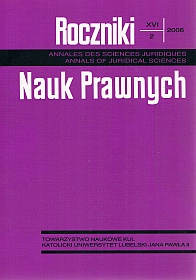Życie religijne korporacji rzemieślniczych w dawnej Polsce
Abstrakt
One of the institutions that played a significant social role in medieval Poland and in later times was craftsmen's corporation called guild. Guilds had essentially two tasks to perform. The first was to foster and develop certain trades. The other was to reinforce the members' religiousness and take care of their morality.
It is the second aspect that is in focus of this study. Although the subject of guilds has already been researched and has earned itself a great deal of specialist literature, this very aspect has not been studied in isolation yet, entirely wrongly. Here, it is exemplified on the basis of several guilds and regards various periods that is periods which belong to Poland of the pre-partition era.
The life of guilds was governed by specific charters which determined the structure and rules of corporations. As far as the structure of liturgical worship, religious practices and religious life in general are concerned, guilds were very similar to another common institution of the time, namely devotional brotherhoods. For this reason some scholars assign both of these institutions the same category of a religious association, whose primary goal was to nurture the religiousness of its members. There are examples proving that occasionally guilds were called -Źor seen as equal to – brotherhoods. According to studies carried out in different towns, the activity of guilds often resembled that of religious brotherhoods.
There is no uniform opinion among scholars as to the significance and meaning of religious practices for guild members. Some believe that religious tasks provided for by guild charters were not of primary importance, others consider these religious considerations to be the foundation of guilds. Apparently, this was illustrated by the fact that the older a charter was the more attention it attached to religious regulations.
The article presents specific religious manifestations and practices. It also demonstrates how meaningful they really were for guilds. It is instructive to analyze the manner in which guilds organized funeral proceedings for the deceased members. Funeral ceremonies were thoroughly Christian in character. Guild members were additionally expected to participate in church services, processions and look after chapels, altars, candles and votive objects. There is evidence that they attended catechism classes.
Guilds, similarly to brotherhoods, were nearly always close to churches, in which they had their own chapels or altars devoted to their patron saints. As a rule, they also had patronage rights to them and these were usually recorded in visitation files. This documentation, apart from the charters, is the second most important source of information about guilds used by scholars.
Copyright (c) 2006 Roczniki Nauk Prawnych

Utwór dostępny jest na licencji Creative Commons Uznanie autorstwa – Użycie niekomercyjne – Bez utworów zależnych 4.0 Międzynarodowe.


